Analysis of a Project Leader: ADCO Constructions and Leadership Styles
VerifiedAdded on 2020/05/11
|10
|2436
|28
Report
AI Summary
This report provides a comprehensive analysis of a project leader's role and effectiveness within ADCO Constructions, focusing on the Richmond Development Project. The report examines the leadership style adopted by Daniel Meiklejohn, the construction manager, identifying it as transformational, and assessing its impact across the project lifecycle. It highlights the leader's 'can do' attitude and its influence on team motivation, task delegation, and project outcomes. The analysis delves into the effectiveness of the leadership behaviors, such as exceptional individual skills, lower staff turnover, and new initiatives, and their contribution to the project's success. The report also explores how leadership behaviors, including empowerment and contingent rewards, have influenced project phases and outcomes. The conclusion reiterates the challenges faced by project leaders and emphasizes the positive impact of transformational leadership on project management and stakeholder satisfaction. The report references several academic sources to support its findings.
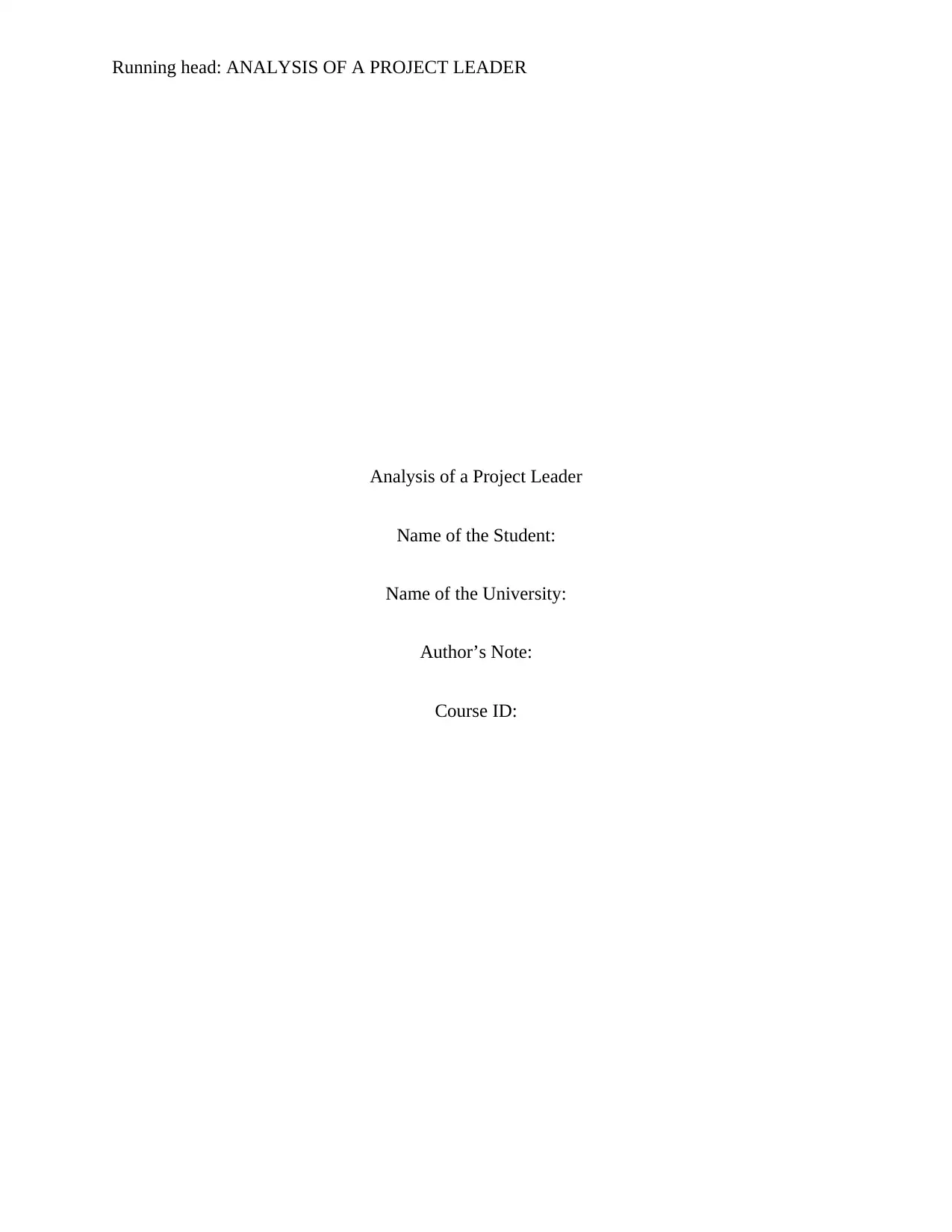
Running head: ANALYSIS OF A PROJECT LEADER
Analysis of a Project Leader
Name of the Student:
Name of the University:
Author’s Note:
Course ID:
Analysis of a Project Leader
Name of the Student:
Name of the University:
Author’s Note:
Course ID:
Secure Best Marks with AI Grader
Need help grading? Try our AI Grader for instant feedback on your assignments.
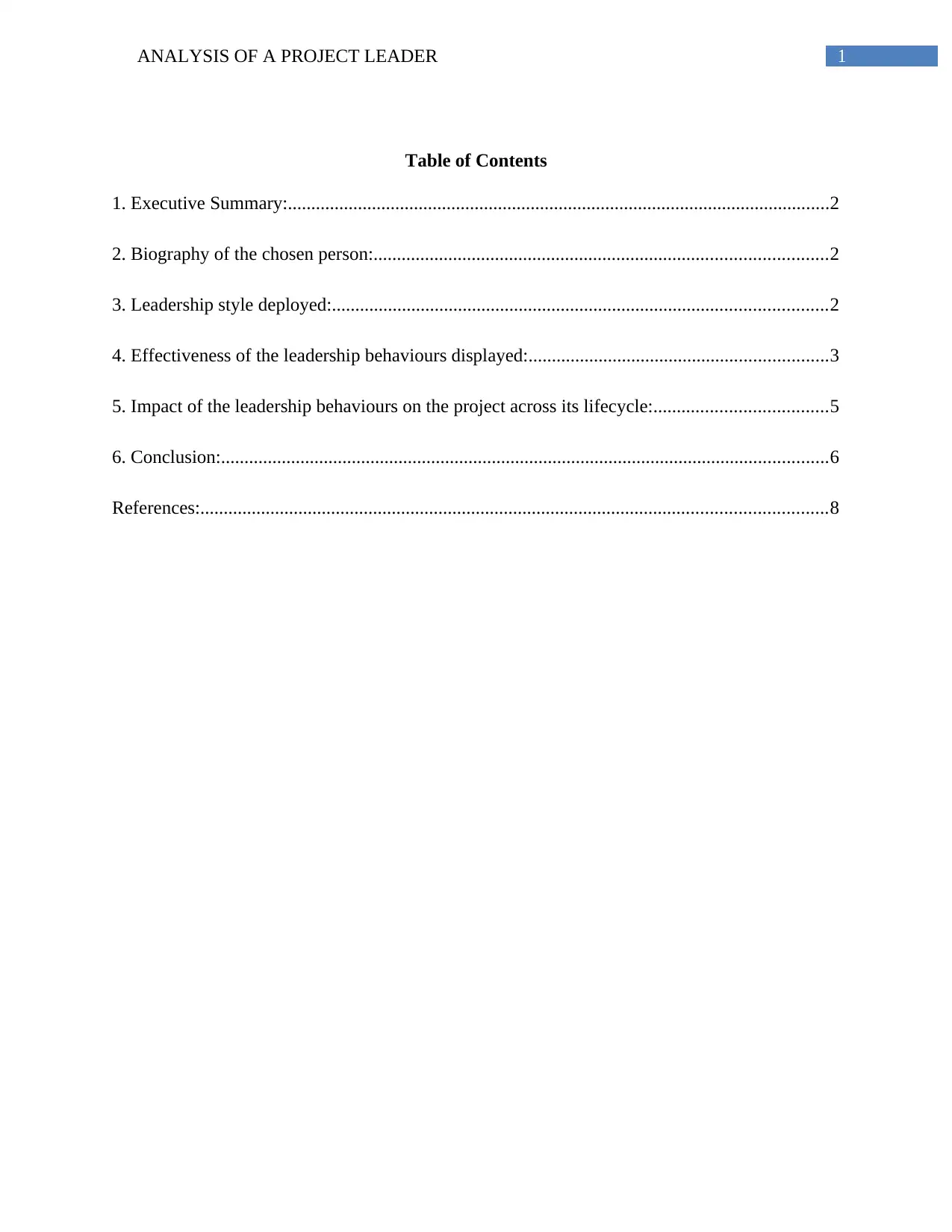
1ANALYSIS OF A PROJECT LEADER
Table of Contents
1. Executive Summary:....................................................................................................................2
2. Biography of the chosen person:.................................................................................................2
3. Leadership style deployed:..........................................................................................................2
4. Effectiveness of the leadership behaviours displayed:................................................................3
5. Impact of the leadership behaviours on the project across its lifecycle:.....................................5
6. Conclusion:..................................................................................................................................6
References:......................................................................................................................................8
Table of Contents
1. Executive Summary:....................................................................................................................2
2. Biography of the chosen person:.................................................................................................2
3. Leadership style deployed:..........................................................................................................2
4. Effectiveness of the leadership behaviours displayed:................................................................3
5. Impact of the leadership behaviours on the project across its lifecycle:.....................................5
6. Conclusion:..................................................................................................................................6
References:......................................................................................................................................8
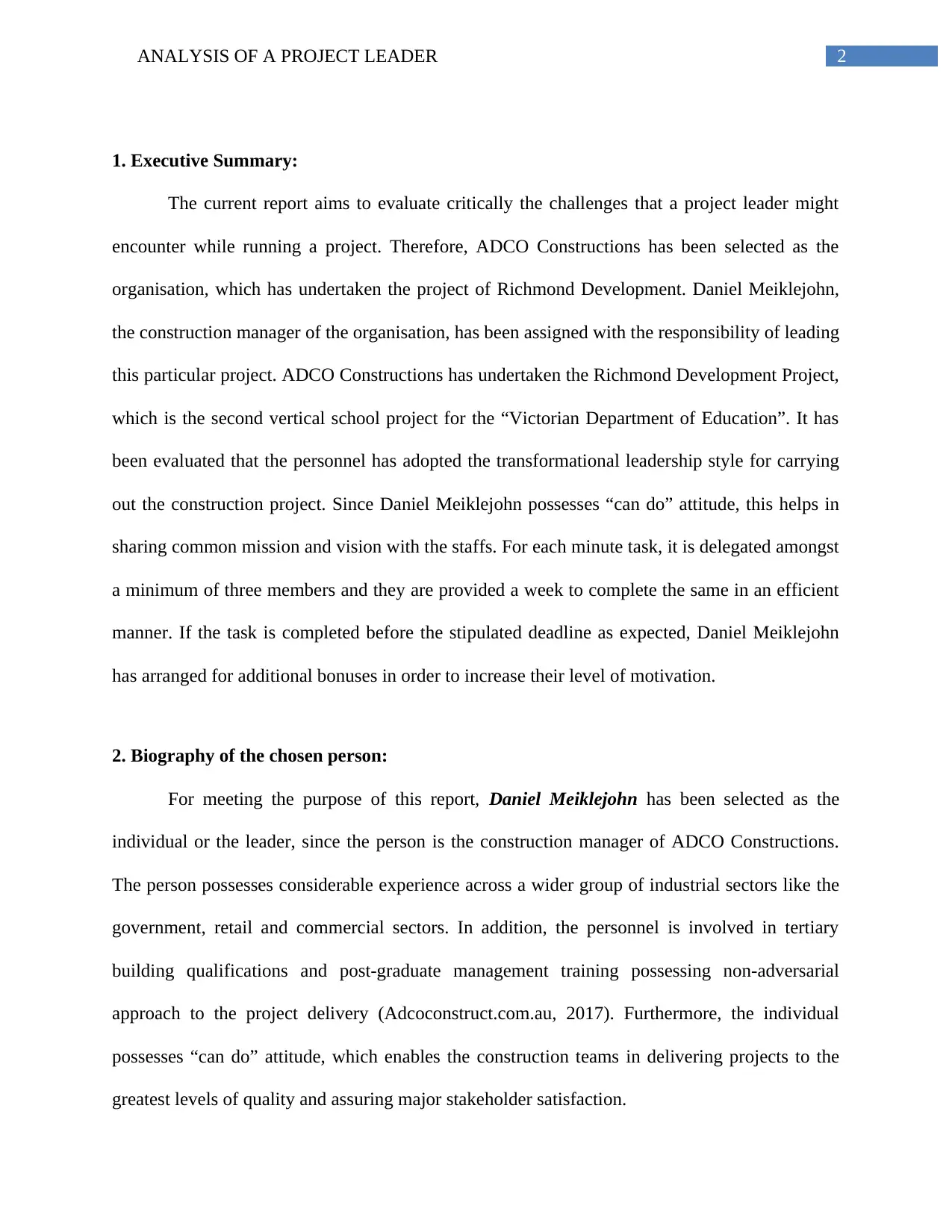
2ANALYSIS OF A PROJECT LEADER
1. Executive Summary:
The current report aims to evaluate critically the challenges that a project leader might
encounter while running a project. Therefore, ADCO Constructions has been selected as the
organisation, which has undertaken the project of Richmond Development. Daniel Meiklejohn,
the construction manager of the organisation, has been assigned with the responsibility of leading
this particular project. ADCO Constructions has undertaken the Richmond Development Project,
which is the second vertical school project for the “Victorian Department of Education”. It has
been evaluated that the personnel has adopted the transformational leadership style for carrying
out the construction project. Since Daniel Meiklejohn possesses “can do” attitude, this helps in
sharing common mission and vision with the staffs. For each minute task, it is delegated amongst
a minimum of three members and they are provided a week to complete the same in an efficient
manner. If the task is completed before the stipulated deadline as expected, Daniel Meiklejohn
has arranged for additional bonuses in order to increase their level of motivation.
2. Biography of the chosen person:
For meeting the purpose of this report, Daniel Meiklejohn has been selected as the
individual or the leader, since the person is the construction manager of ADCO Constructions.
The person possesses considerable experience across a wider group of industrial sectors like the
government, retail and commercial sectors. In addition, the personnel is involved in tertiary
building qualifications and post-graduate management training possessing non-adversarial
approach to the project delivery (Adcoconstruct.com.au, 2017). Furthermore, the individual
possesses “can do” attitude, which enables the construction teams in delivering projects to the
greatest levels of quality and assuring major stakeholder satisfaction.
1. Executive Summary:
The current report aims to evaluate critically the challenges that a project leader might
encounter while running a project. Therefore, ADCO Constructions has been selected as the
organisation, which has undertaken the project of Richmond Development. Daniel Meiklejohn,
the construction manager of the organisation, has been assigned with the responsibility of leading
this particular project. ADCO Constructions has undertaken the Richmond Development Project,
which is the second vertical school project for the “Victorian Department of Education”. It has
been evaluated that the personnel has adopted the transformational leadership style for carrying
out the construction project. Since Daniel Meiklejohn possesses “can do” attitude, this helps in
sharing common mission and vision with the staffs. For each minute task, it is delegated amongst
a minimum of three members and they are provided a week to complete the same in an efficient
manner. If the task is completed before the stipulated deadline as expected, Daniel Meiklejohn
has arranged for additional bonuses in order to increase their level of motivation.
2. Biography of the chosen person:
For meeting the purpose of this report, Daniel Meiklejohn has been selected as the
individual or the leader, since the person is the construction manager of ADCO Constructions.
The person possesses considerable experience across a wider group of industrial sectors like the
government, retail and commercial sectors. In addition, the personnel is involved in tertiary
building qualifications and post-graduate management training possessing non-adversarial
approach to the project delivery (Adcoconstruct.com.au, 2017). Furthermore, the individual
possesses “can do” attitude, which enables the construction teams in delivering projects to the
greatest levels of quality and assuring major stakeholder satisfaction.
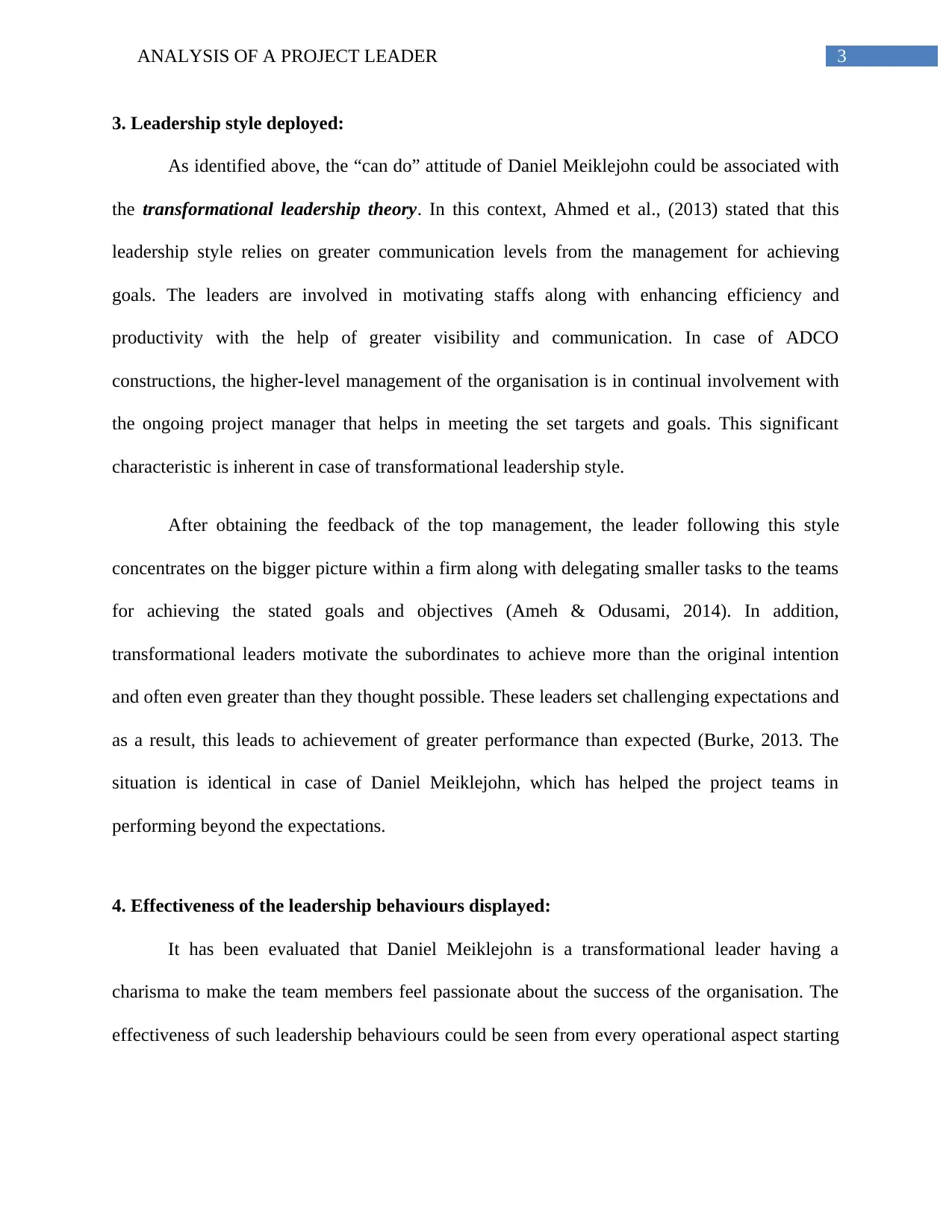
3ANALYSIS OF A PROJECT LEADER
3. Leadership style deployed:
As identified above, the “can do” attitude of Daniel Meiklejohn could be associated with
the transformational leadership theory. In this context, Ahmed et al., (2013) stated that this
leadership style relies on greater communication levels from the management for achieving
goals. The leaders are involved in motivating staffs along with enhancing efficiency and
productivity with the help of greater visibility and communication. In case of ADCO
constructions, the higher-level management of the organisation is in continual involvement with
the ongoing project manager that helps in meeting the set targets and goals. This significant
characteristic is inherent in case of transformational leadership style.
After obtaining the feedback of the top management, the leader following this style
concentrates on the bigger picture within a firm along with delegating smaller tasks to the teams
for achieving the stated goals and objectives (Ameh & Odusami, 2014). In addition,
transformational leaders motivate the subordinates to achieve more than the original intention
and often even greater than they thought possible. These leaders set challenging expectations and
as a result, this leads to achievement of greater performance than expected (Burke, 2013. The
situation is identical in case of Daniel Meiklejohn, which has helped the project teams in
performing beyond the expectations.
4. Effectiveness of the leadership behaviours displayed:
It has been evaluated that Daniel Meiklejohn is a transformational leader having a
charisma to make the team members feel passionate about the success of the organisation. The
effectiveness of such leadership behaviours could be seen from every operational aspect starting
3. Leadership style deployed:
As identified above, the “can do” attitude of Daniel Meiklejohn could be associated with
the transformational leadership theory. In this context, Ahmed et al., (2013) stated that this
leadership style relies on greater communication levels from the management for achieving
goals. The leaders are involved in motivating staffs along with enhancing efficiency and
productivity with the help of greater visibility and communication. In case of ADCO
constructions, the higher-level management of the organisation is in continual involvement with
the ongoing project manager that helps in meeting the set targets and goals. This significant
characteristic is inherent in case of transformational leadership style.
After obtaining the feedback of the top management, the leader following this style
concentrates on the bigger picture within a firm along with delegating smaller tasks to the teams
for achieving the stated goals and objectives (Ameh & Odusami, 2014). In addition,
transformational leaders motivate the subordinates to achieve more than the original intention
and often even greater than they thought possible. These leaders set challenging expectations and
as a result, this leads to achievement of greater performance than expected (Burke, 2013. The
situation is identical in case of Daniel Meiklejohn, which has helped the project teams in
performing beyond the expectations.
4. Effectiveness of the leadership behaviours displayed:
It has been evaluated that Daniel Meiklejohn is a transformational leader having a
charisma to make the team members feel passionate about the success of the organisation. The
effectiveness of such leadership behaviours could be seen from every operational aspect starting
Secure Best Marks with AI Grader
Need help grading? Try our AI Grader for instant feedback on your assignments.
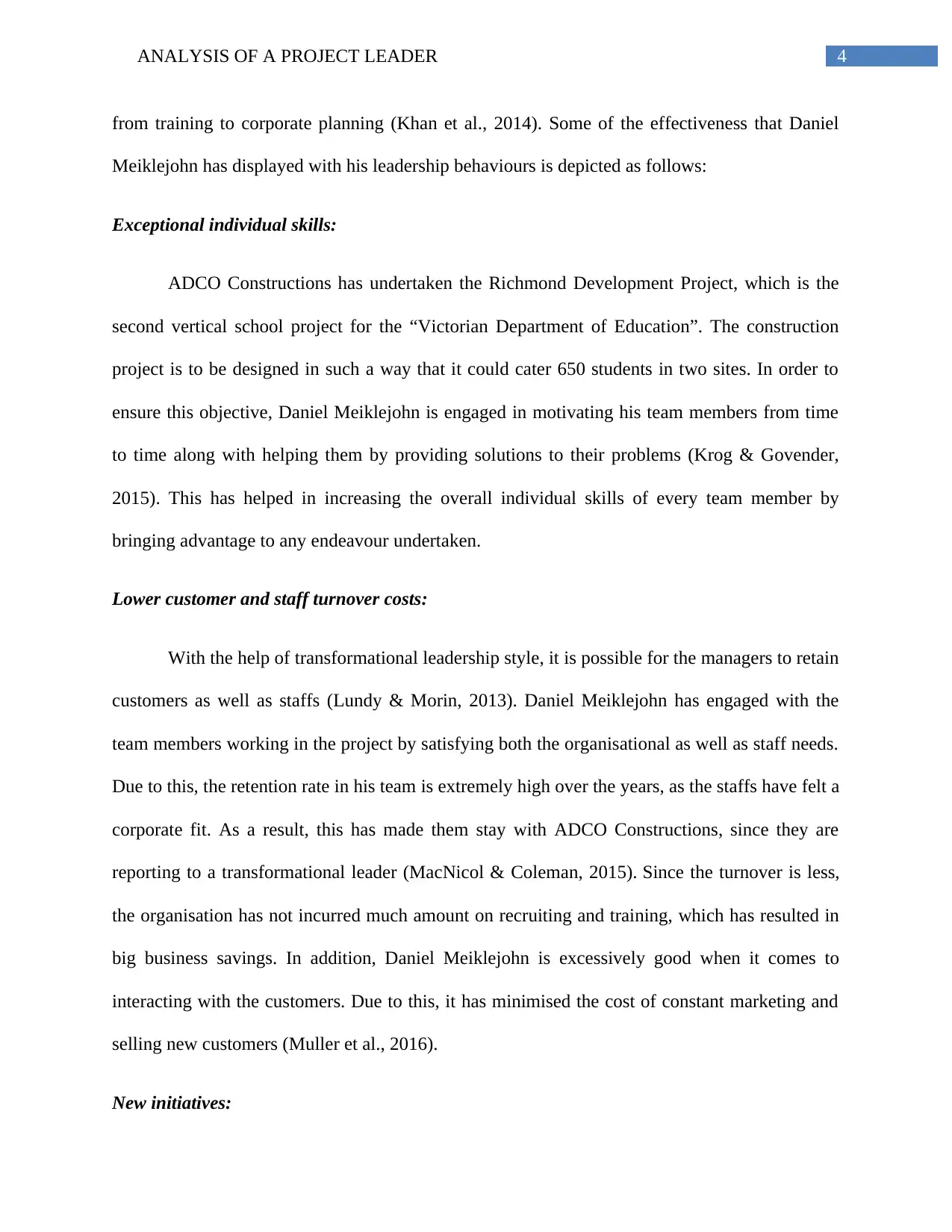
4ANALYSIS OF A PROJECT LEADER
from training to corporate planning (Khan et al., 2014). Some of the effectiveness that Daniel
Meiklejohn has displayed with his leadership behaviours is depicted as follows:
Exceptional individual skills:
ADCO Constructions has undertaken the Richmond Development Project, which is the
second vertical school project for the “Victorian Department of Education”. The construction
project is to be designed in such a way that it could cater 650 students in two sites. In order to
ensure this objective, Daniel Meiklejohn is engaged in motivating his team members from time
to time along with helping them by providing solutions to their problems (Krog & Govender,
2015). This has helped in increasing the overall individual skills of every team member by
bringing advantage to any endeavour undertaken.
Lower customer and staff turnover costs:
With the help of transformational leadership style, it is possible for the managers to retain
customers as well as staffs (Lundy & Morin, 2013). Daniel Meiklejohn has engaged with the
team members working in the project by satisfying both the organisational as well as staff needs.
Due to this, the retention rate in his team is extremely high over the years, as the staffs have felt a
corporate fit. As a result, this has made them stay with ADCO Constructions, since they are
reporting to a transformational leader (MacNicol & Coleman, 2015). Since the turnover is less,
the organisation has not incurred much amount on recruiting and training, which has resulted in
big business savings. In addition, Daniel Meiklejohn is excessively good when it comes to
interacting with the customers. Due to this, it has minimised the cost of constant marketing and
selling new customers (Muller et al., 2016).
New initiatives:
from training to corporate planning (Khan et al., 2014). Some of the effectiveness that Daniel
Meiklejohn has displayed with his leadership behaviours is depicted as follows:
Exceptional individual skills:
ADCO Constructions has undertaken the Richmond Development Project, which is the
second vertical school project for the “Victorian Department of Education”. The construction
project is to be designed in such a way that it could cater 650 students in two sites. In order to
ensure this objective, Daniel Meiklejohn is engaged in motivating his team members from time
to time along with helping them by providing solutions to their problems (Krog & Govender,
2015). This has helped in increasing the overall individual skills of every team member by
bringing advantage to any endeavour undertaken.
Lower customer and staff turnover costs:
With the help of transformational leadership style, it is possible for the managers to retain
customers as well as staffs (Lundy & Morin, 2013). Daniel Meiklejohn has engaged with the
team members working in the project by satisfying both the organisational as well as staff needs.
Due to this, the retention rate in his team is extremely high over the years, as the staffs have felt a
corporate fit. As a result, this has made them stay with ADCO Constructions, since they are
reporting to a transformational leader (MacNicol & Coleman, 2015). Since the turnover is less,
the organisation has not incurred much amount on recruiting and training, which has resulted in
big business savings. In addition, Daniel Meiklejohn is excessively good when it comes to
interacting with the customers. Due to this, it has minimised the cost of constant marketing and
selling new customers (Muller et al., 2016).
New initiatives:
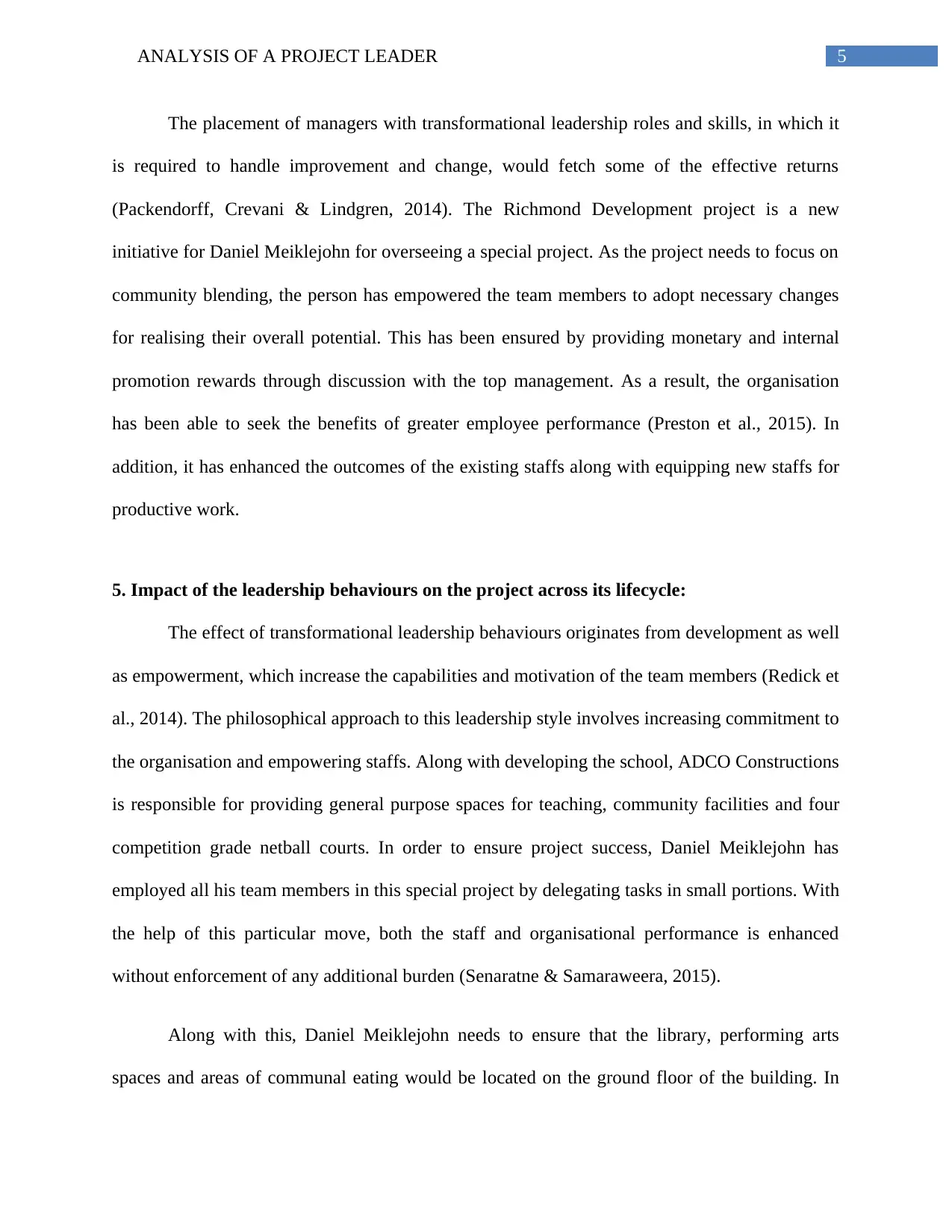
5ANALYSIS OF A PROJECT LEADER
The placement of managers with transformational leadership roles and skills, in which it
is required to handle improvement and change, would fetch some of the effective returns
(Packendorff, Crevani & Lindgren, 2014). The Richmond Development project is a new
initiative for Daniel Meiklejohn for overseeing a special project. As the project needs to focus on
community blending, the person has empowered the team members to adopt necessary changes
for realising their overall potential. This has been ensured by providing monetary and internal
promotion rewards through discussion with the top management. As a result, the organisation
has been able to seek the benefits of greater employee performance (Preston et al., 2015). In
addition, it has enhanced the outcomes of the existing staffs along with equipping new staffs for
productive work.
5. Impact of the leadership behaviours on the project across its lifecycle:
The effect of transformational leadership behaviours originates from development as well
as empowerment, which increase the capabilities and motivation of the team members (Redick et
al., 2014). The philosophical approach to this leadership style involves increasing commitment to
the organisation and empowering staffs. Along with developing the school, ADCO Constructions
is responsible for providing general purpose spaces for teaching, community facilities and four
competition grade netball courts. In order to ensure project success, Daniel Meiklejohn has
employed all his team members in this special project by delegating tasks in small portions. With
the help of this particular move, both the staff and organisational performance is enhanced
without enforcement of any additional burden (Senaratne & Samaraweera, 2015).
Along with this, Daniel Meiklejohn needs to ensure that the library, performing arts
spaces and areas of communal eating would be located on the ground floor of the building. In
The placement of managers with transformational leadership roles and skills, in which it
is required to handle improvement and change, would fetch some of the effective returns
(Packendorff, Crevani & Lindgren, 2014). The Richmond Development project is a new
initiative for Daniel Meiklejohn for overseeing a special project. As the project needs to focus on
community blending, the person has empowered the team members to adopt necessary changes
for realising their overall potential. This has been ensured by providing monetary and internal
promotion rewards through discussion with the top management. As a result, the organisation
has been able to seek the benefits of greater employee performance (Preston et al., 2015). In
addition, it has enhanced the outcomes of the existing staffs along with equipping new staffs for
productive work.
5. Impact of the leadership behaviours on the project across its lifecycle:
The effect of transformational leadership behaviours originates from development as well
as empowerment, which increase the capabilities and motivation of the team members (Redick et
al., 2014). The philosophical approach to this leadership style involves increasing commitment to
the organisation and empowering staffs. Along with developing the school, ADCO Constructions
is responsible for providing general purpose spaces for teaching, community facilities and four
competition grade netball courts. In order to ensure project success, Daniel Meiklejohn has
employed all his team members in this special project by delegating tasks in small portions. With
the help of this particular move, both the staff and organisational performance is enhanced
without enforcement of any additional burden (Senaratne & Samaraweera, 2015).
Along with this, Daniel Meiklejohn needs to ensure that the library, performing arts
spaces and areas of communal eating would be located on the ground floor of the building. In
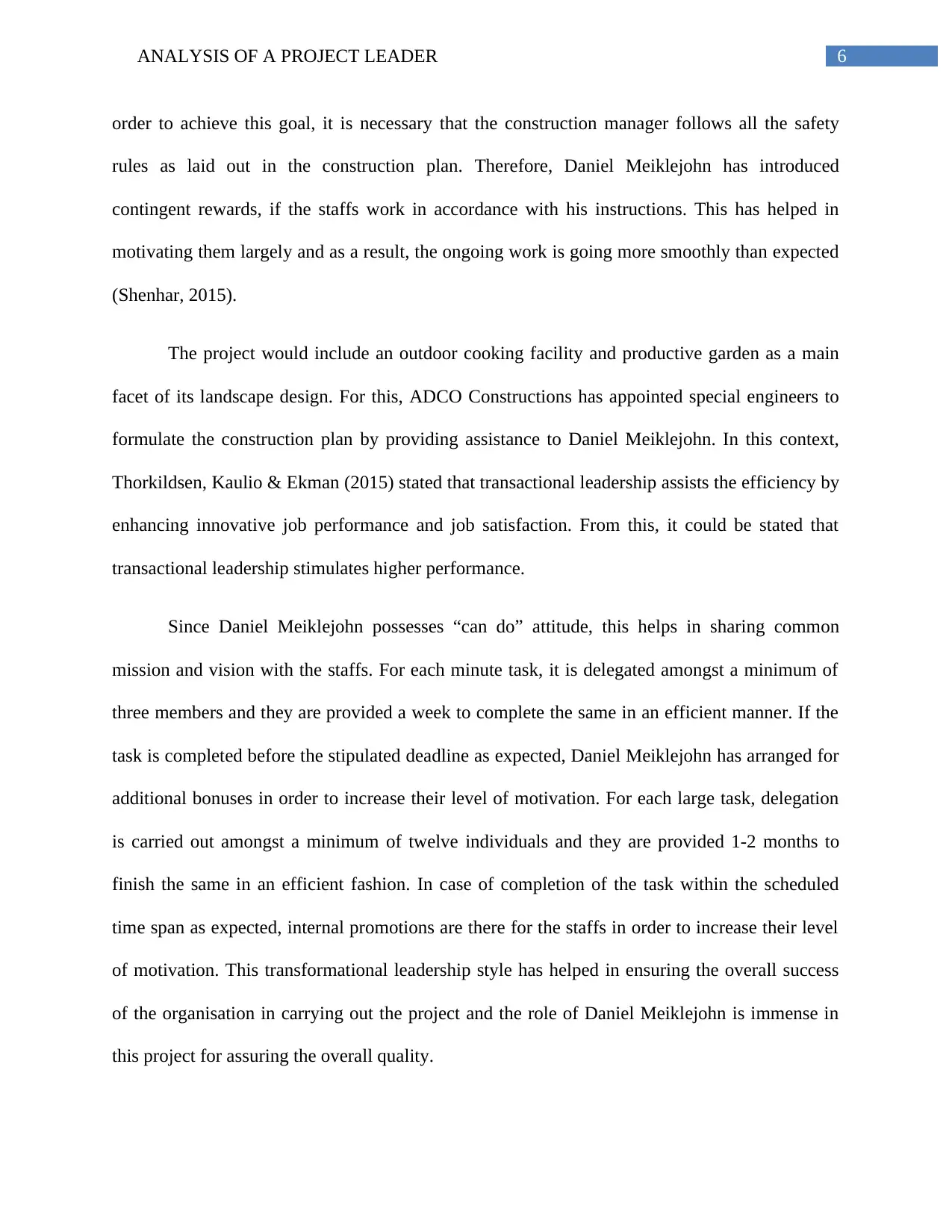
6ANALYSIS OF A PROJECT LEADER
order to achieve this goal, it is necessary that the construction manager follows all the safety
rules as laid out in the construction plan. Therefore, Daniel Meiklejohn has introduced
contingent rewards, if the staffs work in accordance with his instructions. This has helped in
motivating them largely and as a result, the ongoing work is going more smoothly than expected
(Shenhar, 2015).
The project would include an outdoor cooking facility and productive garden as a main
facet of its landscape design. For this, ADCO Constructions has appointed special engineers to
formulate the construction plan by providing assistance to Daniel Meiklejohn. In this context,
Thorkildsen, Kaulio & Ekman (2015) stated that transactional leadership assists the efficiency by
enhancing innovative job performance and job satisfaction. From this, it could be stated that
transactional leadership stimulates higher performance.
Since Daniel Meiklejohn possesses “can do” attitude, this helps in sharing common
mission and vision with the staffs. For each minute task, it is delegated amongst a minimum of
three members and they are provided a week to complete the same in an efficient manner. If the
task is completed before the stipulated deadline as expected, Daniel Meiklejohn has arranged for
additional bonuses in order to increase their level of motivation. For each large task, delegation
is carried out amongst a minimum of twelve individuals and they are provided 1-2 months to
finish the same in an efficient fashion. In case of completion of the task within the scheduled
time span as expected, internal promotions are there for the staffs in order to increase their level
of motivation. This transformational leadership style has helped in ensuring the overall success
of the organisation in carrying out the project and the role of Daniel Meiklejohn is immense in
this project for assuring the overall quality.
order to achieve this goal, it is necessary that the construction manager follows all the safety
rules as laid out in the construction plan. Therefore, Daniel Meiklejohn has introduced
contingent rewards, if the staffs work in accordance with his instructions. This has helped in
motivating them largely and as a result, the ongoing work is going more smoothly than expected
(Shenhar, 2015).
The project would include an outdoor cooking facility and productive garden as a main
facet of its landscape design. For this, ADCO Constructions has appointed special engineers to
formulate the construction plan by providing assistance to Daniel Meiklejohn. In this context,
Thorkildsen, Kaulio & Ekman (2015) stated that transactional leadership assists the efficiency by
enhancing innovative job performance and job satisfaction. From this, it could be stated that
transactional leadership stimulates higher performance.
Since Daniel Meiklejohn possesses “can do” attitude, this helps in sharing common
mission and vision with the staffs. For each minute task, it is delegated amongst a minimum of
three members and they are provided a week to complete the same in an efficient manner. If the
task is completed before the stipulated deadline as expected, Daniel Meiklejohn has arranged for
additional bonuses in order to increase their level of motivation. For each large task, delegation
is carried out amongst a minimum of twelve individuals and they are provided 1-2 months to
finish the same in an efficient fashion. In case of completion of the task within the scheduled
time span as expected, internal promotions are there for the staffs in order to increase their level
of motivation. This transformational leadership style has helped in ensuring the overall success
of the organisation in carrying out the project and the role of Daniel Meiklejohn is immense in
this project for assuring the overall quality.
Paraphrase This Document
Need a fresh take? Get an instant paraphrase of this document with our AI Paraphraser
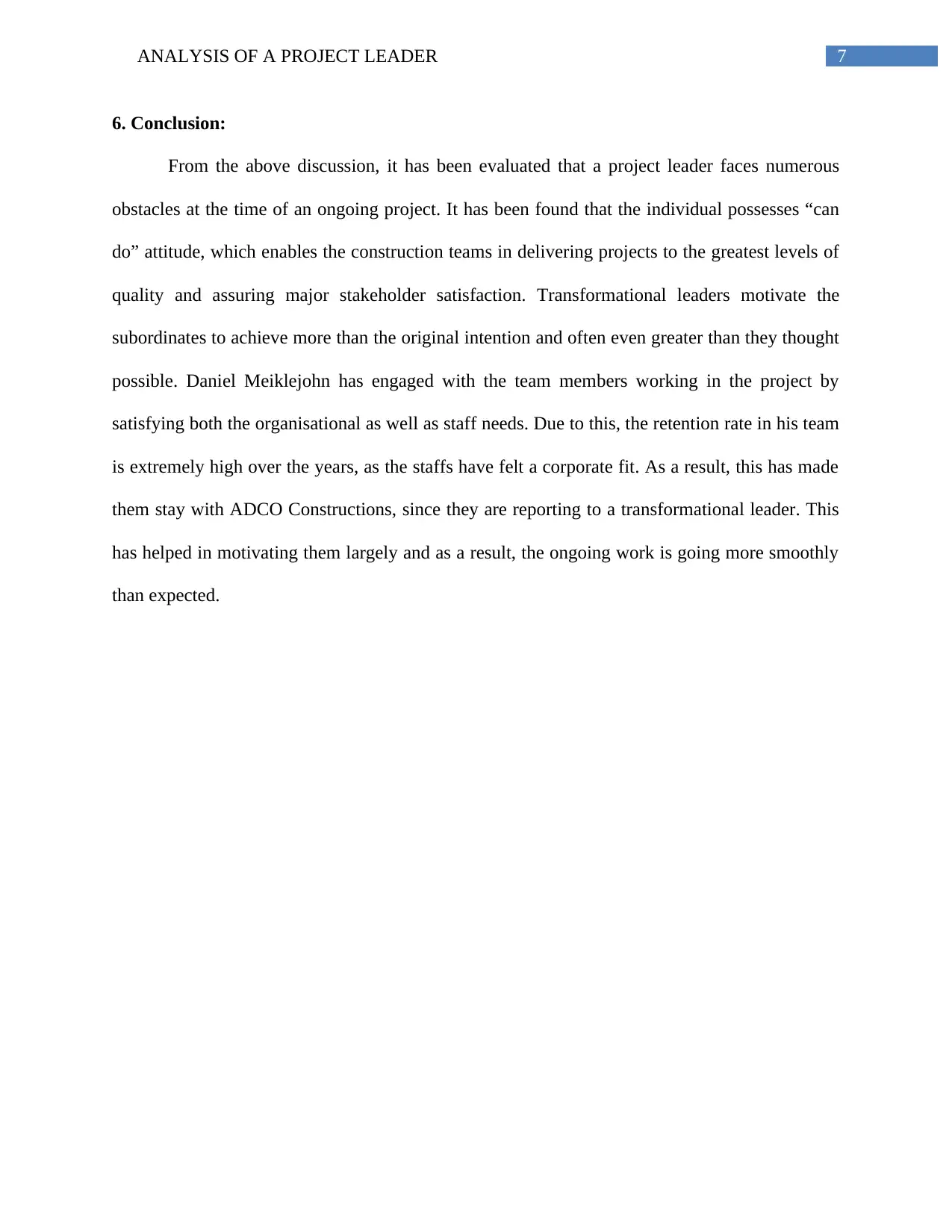
7ANALYSIS OF A PROJECT LEADER
6. Conclusion:
From the above discussion, it has been evaluated that a project leader faces numerous
obstacles at the time of an ongoing project. It has been found that the individual possesses “can
do” attitude, which enables the construction teams in delivering projects to the greatest levels of
quality and assuring major stakeholder satisfaction. Transformational leaders motivate the
subordinates to achieve more than the original intention and often even greater than they thought
possible. Daniel Meiklejohn has engaged with the team members working in the project by
satisfying both the organisational as well as staff needs. Due to this, the retention rate in his team
is extremely high over the years, as the staffs have felt a corporate fit. As a result, this has made
them stay with ADCO Constructions, since they are reporting to a transformational leader. This
has helped in motivating them largely and as a result, the ongoing work is going more smoothly
than expected.
6. Conclusion:
From the above discussion, it has been evaluated that a project leader faces numerous
obstacles at the time of an ongoing project. It has been found that the individual possesses “can
do” attitude, which enables the construction teams in delivering projects to the greatest levels of
quality and assuring major stakeholder satisfaction. Transformational leaders motivate the
subordinates to achieve more than the original intention and often even greater than they thought
possible. Daniel Meiklejohn has engaged with the team members working in the project by
satisfying both the organisational as well as staff needs. Due to this, the retention rate in his team
is extremely high over the years, as the staffs have felt a corporate fit. As a result, this has made
them stay with ADCO Constructions, since they are reporting to a transformational leader. This
has helped in motivating them largely and as a result, the ongoing work is going more smoothly
than expected.
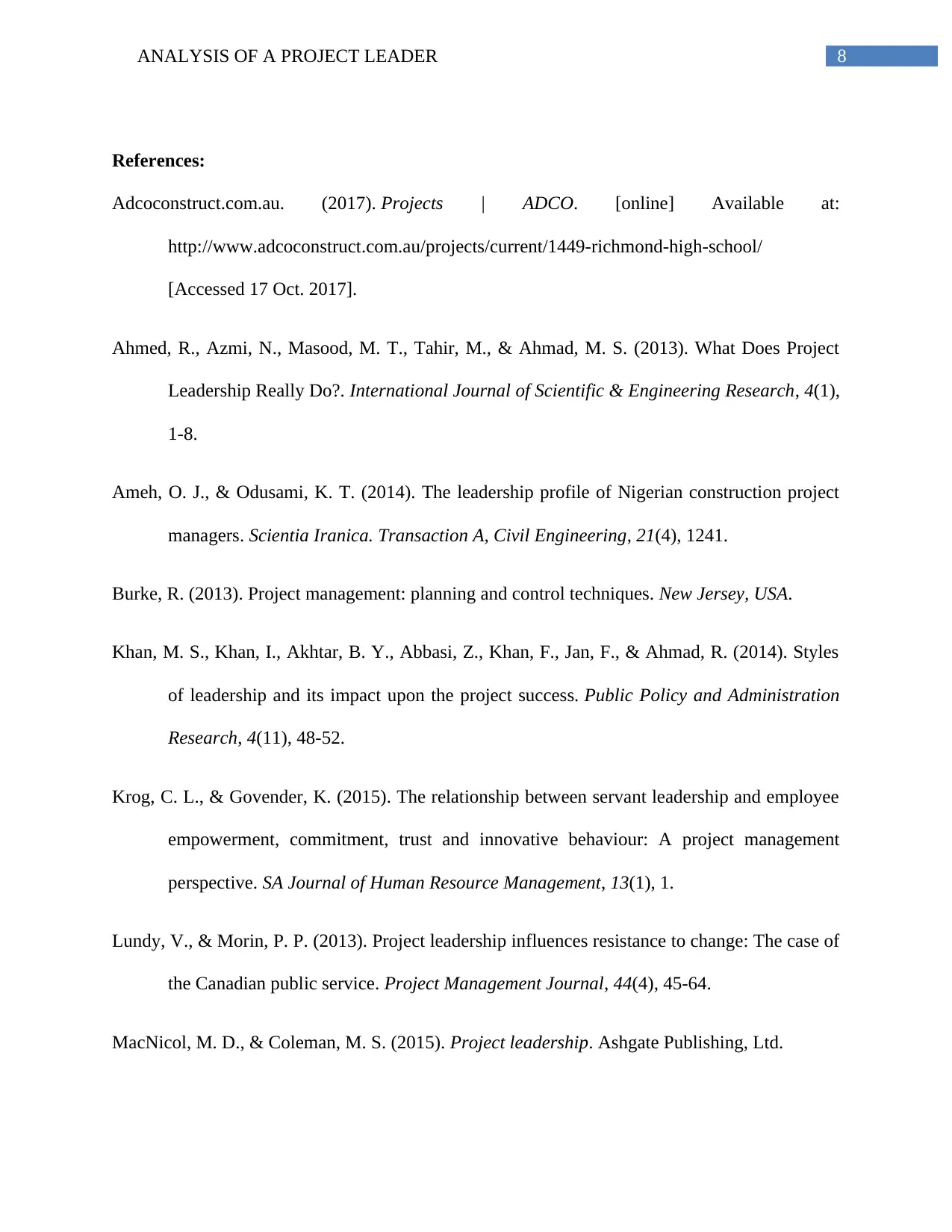
8ANALYSIS OF A PROJECT LEADER
References:
Adcoconstruct.com.au. (2017). Projects | ADCO. [online] Available at:
http://www.adcoconstruct.com.au/projects/current/1449-richmond-high-school/
[Accessed 17 Oct. 2017].
Ahmed, R., Azmi, N., Masood, M. T., Tahir, M., & Ahmad, M. S. (2013). What Does Project
Leadership Really Do?. International Journal of Scientific & Engineering Research, 4(1),
1-8.
Ameh, O. J., & Odusami, K. T. (2014). The leadership profile of Nigerian construction project
managers. Scientia Iranica. Transaction A, Civil Engineering, 21(4), 1241.
Burke, R. (2013). Project management: planning and control techniques. New Jersey, USA.
Khan, M. S., Khan, I., Akhtar, B. Y., Abbasi, Z., Khan, F., Jan, F., & Ahmad, R. (2014). Styles
of leadership and its impact upon the project success. Public Policy and Administration
Research, 4(11), 48-52.
Krog, C. L., & Govender, K. (2015). The relationship between servant leadership and employee
empowerment, commitment, trust and innovative behaviour: A project management
perspective. SA Journal of Human Resource Management, 13(1), 1.
Lundy, V., & Morin, P. P. (2013). Project leadership influences resistance to change: The case of
the Canadian public service. Project Management Journal, 44(4), 45-64.
MacNicol, M. D., & Coleman, M. S. (2015). Project leadership. Ashgate Publishing, Ltd.
References:
Adcoconstruct.com.au. (2017). Projects | ADCO. [online] Available at:
http://www.adcoconstruct.com.au/projects/current/1449-richmond-high-school/
[Accessed 17 Oct. 2017].
Ahmed, R., Azmi, N., Masood, M. T., Tahir, M., & Ahmad, M. S. (2013). What Does Project
Leadership Really Do?. International Journal of Scientific & Engineering Research, 4(1),
1-8.
Ameh, O. J., & Odusami, K. T. (2014). The leadership profile of Nigerian construction project
managers. Scientia Iranica. Transaction A, Civil Engineering, 21(4), 1241.
Burke, R. (2013). Project management: planning and control techniques. New Jersey, USA.
Khan, M. S., Khan, I., Akhtar, B. Y., Abbasi, Z., Khan, F., Jan, F., & Ahmad, R. (2014). Styles
of leadership and its impact upon the project success. Public Policy and Administration
Research, 4(11), 48-52.
Krog, C. L., & Govender, K. (2015). The relationship between servant leadership and employee
empowerment, commitment, trust and innovative behaviour: A project management
perspective. SA Journal of Human Resource Management, 13(1), 1.
Lundy, V., & Morin, P. P. (2013). Project leadership influences resistance to change: The case of
the Canadian public service. Project Management Journal, 44(4), 45-64.
MacNicol, M. D., & Coleman, M. S. (2015). Project leadership. Ashgate Publishing, Ltd.
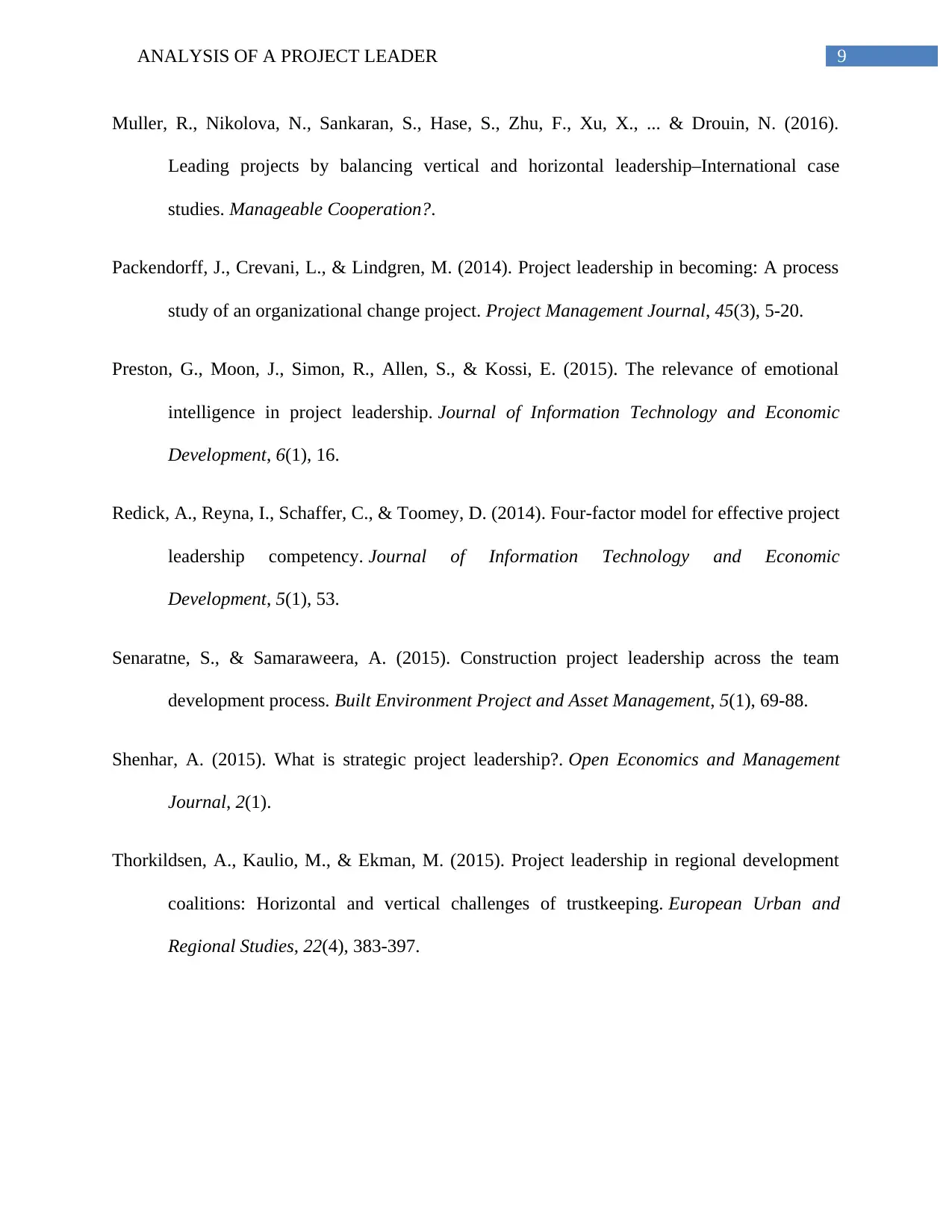
9ANALYSIS OF A PROJECT LEADER
Muller, R., Nikolova, N., Sankaran, S., Hase, S., Zhu, F., Xu, X., ... & Drouin, N. (2016).
Leading projects by balancing vertical and horizontal leadership–International case
studies. Manageable Cooperation?.
Packendorff, J., Crevani, L., & Lindgren, M. (2014). Project leadership in becoming: A process
study of an organizational change project. Project Management Journal, 45(3), 5-20.
Preston, G., Moon, J., Simon, R., Allen, S., & Kossi, E. (2015). The relevance of emotional
intelligence in project leadership. Journal of Information Technology and Economic
Development, 6(1), 16.
Redick, A., Reyna, I., Schaffer, C., & Toomey, D. (2014). Four-factor model for effective project
leadership competency. Journal of Information Technology and Economic
Development, 5(1), 53.
Senaratne, S., & Samaraweera, A. (2015). Construction project leadership across the team
development process. Built Environment Project and Asset Management, 5(1), 69-88.
Shenhar, A. (2015). What is strategic project leadership?. Open Economics and Management
Journal, 2(1).
Thorkildsen, A., Kaulio, M., & Ekman, M. (2015). Project leadership in regional development
coalitions: Horizontal and vertical challenges of trustkeeping. European Urban and
Regional Studies, 22(4), 383-397.
Muller, R., Nikolova, N., Sankaran, S., Hase, S., Zhu, F., Xu, X., ... & Drouin, N. (2016).
Leading projects by balancing vertical and horizontal leadership–International case
studies. Manageable Cooperation?.
Packendorff, J., Crevani, L., & Lindgren, M. (2014). Project leadership in becoming: A process
study of an organizational change project. Project Management Journal, 45(3), 5-20.
Preston, G., Moon, J., Simon, R., Allen, S., & Kossi, E. (2015). The relevance of emotional
intelligence in project leadership. Journal of Information Technology and Economic
Development, 6(1), 16.
Redick, A., Reyna, I., Schaffer, C., & Toomey, D. (2014). Four-factor model for effective project
leadership competency. Journal of Information Technology and Economic
Development, 5(1), 53.
Senaratne, S., & Samaraweera, A. (2015). Construction project leadership across the team
development process. Built Environment Project and Asset Management, 5(1), 69-88.
Shenhar, A. (2015). What is strategic project leadership?. Open Economics and Management
Journal, 2(1).
Thorkildsen, A., Kaulio, M., & Ekman, M. (2015). Project leadership in regional development
coalitions: Horizontal and vertical challenges of trustkeeping. European Urban and
Regional Studies, 22(4), 383-397.
1 out of 10
Related Documents
Your All-in-One AI-Powered Toolkit for Academic Success.
+13062052269
info@desklib.com
Available 24*7 on WhatsApp / Email
![[object Object]](/_next/static/media/star-bottom.7253800d.svg)
Unlock your academic potential
© 2024 | Zucol Services PVT LTD | All rights reserved.





